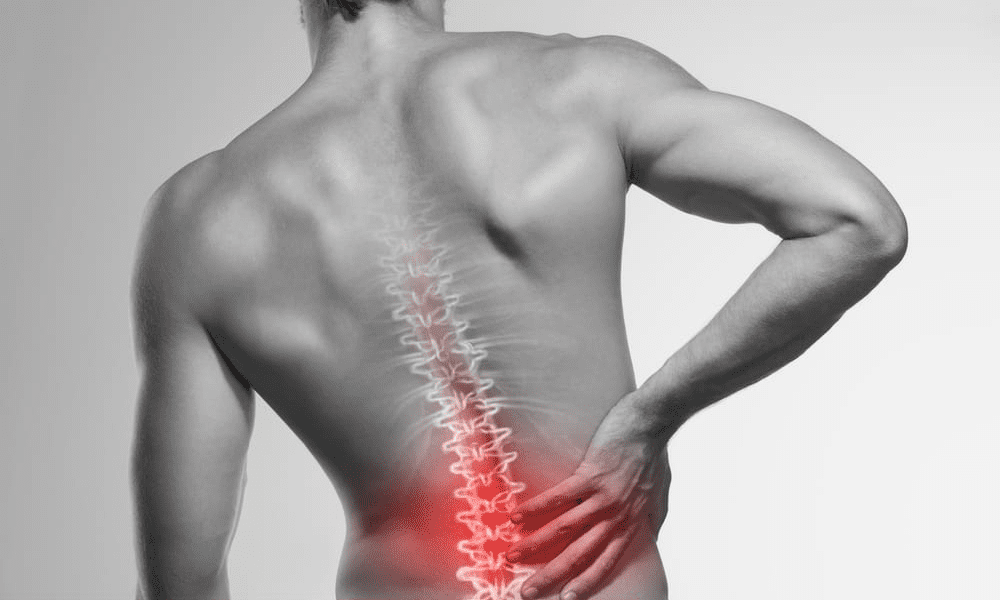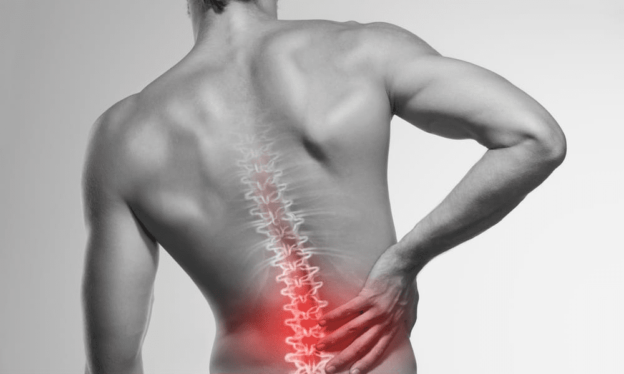Spinal pain is one of the most common reasons for a visit to best spine doctor in Guntur. The spine is one of the most sensitive areas in the body and can be easily bruised or injured by falls, sports, accidents, and more.
Spinal Pain in your lower back or Lumbar Region is a pain that typically is caused by something disturbing the joints and the area of the spinal discs. It has been found that disturbing low back pain is associated with disorders of the spinal and peripheral nerves.
Conditions that can include sciatica, disc herniation, degenerative joint disease (osteoarthritis), degenerative disc disease, spondylolisthesis and facet joint syndrome in some cases.

Symptoms of Spinal Pain
In some cases, patients will experience no symptoms when suffering from spine injuries or diseases. However, in most cases a patient will have pain in their lower back or abdomen that can include:
• Sharp or Burning Sensation
• Tenderness
• Aches and Pains in the muscles and the bones where the spine meets the pelvis. This is usually found in your hips, buttocks and sometimes your shoulders.
• Difficulty sleeping
• Reduced range of motion or muscle strength or Stiffness in the Lower Back
• Weakness and fatigue of muscles used to stabilize the spine, limbs, and torso
• Numbness or tingling in certain areas of the body caused by nerve irritation. The most common are related to the legs (peroneal nerve).
Diagnosis and Testing Of Spinal Pain
Patients will first be referred for an X-ray and then an MRI to see what is going on with the spine. Patients will also have their symptoms and medical history recorded along with their physical findings. It can be done easily in Dr Rao Hospital which is the best spine surgery hospital in India.
X-Ray- X-rays are used by doctors to determine the position and size of bones, broken bones and abnormal changes in the normal structure of the spine. The X-ray is taken with different views so that it can identify any unusual changes in the spinal structure.
MRI (Magnetic Resonance Imaging) – A MRI is an advanced imaging technique that uses a magnetic field, radio waves, and a computer to take pictures of soft tissue structures in the body. It shows the spinal cord and nerve roots that help with signals being sent to the brain.
These are important to find out if something is wrong with the spinal cord and its actual position in the body. An MRI can also show bony abnormalities and damaged soft tissue. As well as problems within the discs and ligaments of the spine that are causing pain.
CT-Scan – A CT scan or CAT scan is a diagnostic imaging procedure that uses X-rays and computer technology to produce cross-sectional images (often called slices), both horizontally and vertically, of the body.
Once an accurate diagnosis has been made, the Best spine doctor in Guntur can formulate a treatment plan that is best suited to your needs. This plan may include different types of therapies such as Spinal Manipulation, Laser Therapy, Muscle Relaxants, Pain Medications and more.
Treatment Of Spinal Pain
Non-Surgical Treatment
Although there is no one cures for spinal pain, some causes of chronic back pain can be treated so that patients will not experience any more pain or symptoms. Some steps taken toward non-surgical treatment of chronic back pain include:
• Exercise program- Patients with chronic back pain should start an exercise program.
• Medications-Most spine specialists in Guntur will first recommend medication to relieve your symptoms so that you can endure other treatments when necessary. Drug treatment options include over-the-counter pain relievers, anti-inflammatory drugs, muscle relaxants, and even opiates when necessary.
These medications ease the inflammation in your spine which allows you to perform physical therapy or other treatments that might be required without pain.
• Physical Therapy – Physical therapy is one of the most effective methods of treating spinal pain. Physical therapy helps strengthen and stabilize your muscles. Also, physical therapy will help you learn how to use your muscles more efficiently and effectively.

Surgical Treatment
When these techniques are not sufficient to treat back pain, the best spine surgeon in Andhra Pradesh may recommend surgery to correct the problem. Surgery for spinal pain usually takes place in locations like an Neurosurgeon’s office or a hospital operating room.
Spinal Fusion: Spinal Fusion is a surgery that helps stabilize the spine. During this procedure, the surgeon will fuse two or more vertebrae by inserting a bone graft between them and then holding it in place with metal screws. This procedure is an effective way of pain relief from symptoms of degenerative disc disease, spinal stenosis and scoliosis.
Discectomy: A discectomy is performed when a herniated disc presses on one or more nerves, causing back pain and/or sciatica.
During this surgery, the disc material that is pressing on a nerve will be removed to relieve any pressure along with removing any irritated tissue around the nerve itself.

A. Cervical Discectomy: During this procedure, the spine surgeon will remove any disc material that is causing pressure on the nerve roots, or at a level where it is pressing against and irritating one or more of those nerves. In some cases, depending on the severity of your condition, this surgery may be accompanied by a fusion.
Lumbar disc arthroplasty: This surgery is most frequently performed on patients who have lumbar spinal stenosis. The surgeon will remove the disc that is causing pressure on the nerve, along with the disc material within the spinal canal and then insert an artificial disc. This helps to maintain the normal spacing between vertebrae and relieve pressure on any nerves in your spine.
Cervical disc herniation and arthroplasty: This is performed when a herniated disc presses on the nerve roots or at a level where it is pressing against and irritating one or more of those nerves. During this procedure, the surgeon will remove that disc and then insert an artificial disc.
This helps to maintain the normal spacing between vertebrae and relieve pressure on any nerves in your spine. This surgery helps relieve pressure on the spinal cord and nerve roots in the cervical spine which are responsible for causing pain in the neck and upper back. A disc replacement and artificial disc are inserted.
Laminectomy: This procedure is done when there are multiple problems with the spine. Including bone spurs, bone malformations or disc problems that have caused degeneration of the vertebrae (spondylosis).
This can often cause pain and discomfort as well as degeneration in the spinal cord (nerve damage). During this surgery, the spine surgeon in Guntur will fuse two or more vertebrae by inserting a bone graft between them.
Microdiscectomy: A microdiscectomy is performed to remove only the portion of the disc that is compressing the nerve and causing pain. During this procedure, the spine surgeon will remove only that portion of the disc that is pressed against the nerve or spinal cord and then insert an artificial disc. This helps to maintain the normal spacing between vertebrae and relieve pressure on any nerves in your spine.
Minimally invasive keyhole spine surgery is always better than traditional open surgery. Minimally invasive MIS surgery have advantages of less scarring, less muscle damage, less pain, less blood loss, less hospital stay, immediate walking, less time to resume work e.t.c.
Post Surgery Precautions
Following spinal fusion surgery, certain precautions must be taken to help prevent complications. It is important to keep your back hydrated by drinking plenty of water and taking pain medication as prescribed by your doctor, during the first few days or weeks following surgery.

• The surgeon may suggest frequent follow-up visits with a Physical Therapist after surgery.
• Be sure to avoid any physical activity or work that will put extra strain on your back for some time.
• Take it easy. Don’t lift anything too heavy or carry anything too heavy more than 10 pounds. Especially when getting over the threshold of a doorway or through narrow spaces like a car trunk.
• Avoid driving and other activities that require you to twist your body while seated. Such as working at the computer while seated on an exercise ball.
• Be sure to take your pain medication as prescribed by your doctor. (usually according to how much pain you’re in). If you’re not taking pain medication because of side effects, Talk to your spine surgeon about the possibility of switching medications or lowering the dosage until side effects subside.
• If you’re having a lot of trouble sitting for long periods, talk to your doctor about wearing a back brace. Your surgeon may recommend that you wear this brace even after the surgery is complete.
• Avoid overusing the muscles in your legs, especially if you have weak abdominal muscles.
• Drink plenty of water throughout the day to keep yourself hydrated and avoid dehydration.


